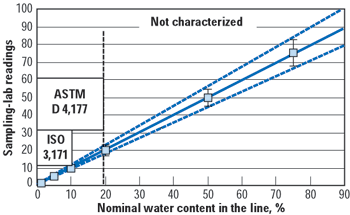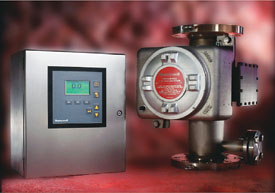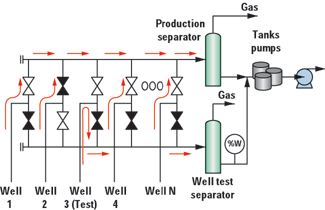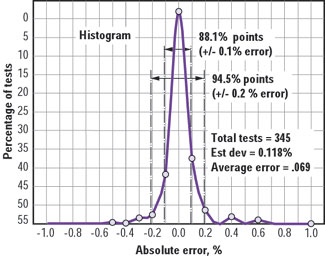Automation & Control
New technique allows real-time watercut monitoring in oil production
Based on field evaluations, the new technology gives precise water/oil measurement, effective automation of oil recovery operations, improved reservoir management, and lower costs for sampling, well operation and maintenance
Mario Giallorenzo and Michele Loseto, PDVSA-Intevep Lawrence Vanell, Honeywell Industrial Measurement and Control
Watercut monitoring is essential for well-test separators, flow stations, oil treatment plants, and oil sales tank farms. Knowing and controlling water/oil content improves the efficiency of oil recovery, minimizes transport of water, and maximizes oil quality by improving the dehydration process. Online water supervision is essential for reservoir management and production optimization, enabling reliable and continuous net-oil production estimation, well diagnostics/maintenance and reservoir model adjustment.
BACKGROUND
Oil companies traditionally have determined watercut by taking a sample and analyzing it through lab methods. However, the relative uncertainty associated with this method often exceeds acceptable standards, with measurements only accurately characterized up to 10% of water content, Fig. 1.
 |
Fig. 1. Expected water content deviations of sampling lab method.
|
|
Factors contributing to sampling lab uncertainty include: nominal and relative water content in the pipe/flow line; relative error due to flow changes, contamination or vapor loss; and relative changes in water content due to sampling, handling and mixing, as well as transfer to laboratory glassware and analysis.
The initial trend in watercut applications was to use either low-range (water-in-oil mixtures) or high-range (oil-in-water mixtures) bi-phase watercut meters. Full range (0–100%) meters were later developed, but proved difficult to calibrate in the field.
CHALLENGES
The dynamic nature of oil production makes precise watercut measurement difficult. For example, well or flowline slugging and/or periodic dumping in discontinuous well-test separators impacts water-oil stratification, and watercut can vary from 0 to 100% during the process. Another complicating factor is gas in the liquid outlet due to incomplete gas-liquid separation.
Mixing to achieve homogeneity within piping is generally misunderstood by end users, many of whom may not realize that a proper water-oil mixture is a prerequisite for measuring at a single point on a pipeline.
The need for continuous, real-time water content monitoring, coupled with strict industry standards such as ISO 3171 and ASTM D 4177 covering test methods for automatic petroleum sampling, have prompted oil companies to seek new, online measurement solutions.
EXISTING TECHNOLOGIES
Existing systems for watercut measurement use a wide range of technologies, including admittance, capacitance, microwave and infrared. These systems differ in the way they are operated and calibrated in the field, and in their ability to handle various oil/water mixtures.
Capacitance-based meters are only suitable for water-in-oil mixtures, and are not compatible with continuous-phase mixtures exhibiting non-linear electrical properties. This reduces the meters’ operating range to about 0–5%.
Microwave-based analyzers generally do not behave well with oil-in-water mixtures because their scale span must be adjusted with indirect variables. Also, most of them do not consider temperature dependence. In water-in-oil mixtures, some microwave analyzers require manual adjustment of parameters via procedures that cannot be performed in the field.
Coriolis flowmeters can only be used for watercut measurement when there is a good density contrast between water and oil, such as with light oil. Even in this case, they have a very low tolerance to gas presence.
NEW TECHNIQUE
An innovative measurement technique jointly developed by PDVSA-Intevep, a subsidiary of Petroleos de Venezuela, and Honeywell Industrial Measurement and Control, provides a new alternative for monitoring water content in petroleum recovery operations. This technique is available in Honeywell's H2Oil Analyzer System, which employs PDVSA-Intevep's WOCAMETER® technology. The technology can be used from 0 to 100% water content, while still providing the high accuracy in low water concentration that is essential for oil quality supervision.
The H2Oil system comprises an inline flanged sensor module, a remote analyzer serving as the Human Machine Interface, and a calibration device, Fig. 2. A single unit handles up to 34 different oil/water process mixtures, including dispersions/emulsions with continuous water or oil phase, and mixtures containing varying amounts of gas.
 |
Fig. 2. Honeywell’s H2Oil Analyzer System.
|
|
Watercut measurement is based on determining the intrinsic electrical properties (dielectric constant and conductivity) of the liquid flow. It starts with an electrical admittance calculation of the water mixture in continuous-oil phase (water droplets suspended in oil) or continuous-water phase (oil droplets suspended in water) and leads to an analytical model for identifying the percentage of water.
The instrument measures the percentage of water in a stream of oil as occurs in production from a field or well test separator. It does this without obstructing flow. Using the electrical, simultaneous admittance calculation of the water/oil mixture, the analytical software model determines the accurate percentage of water in oil. It makes this determination in continuous-oil phase or continuous-water phase conditions through the entire composition range of 0 to 100% water.
Where water is the continuous phase, increases in oil content can be detected by increases in electrical resistivity. Where oil is the continuous phase, increases in water content may be detected by increases in electrical capacitance. The same electrodes may be used for both measurements. The two conduction mechanisms interact, but the real conductance/capacitance contributions to the overall admittance can be measured simultaneously with the patented technology upon which the analyzer is based. The measurement model allows automatic determination of which phase (water or oil) is continuous.
A unique characteristic of the new analyzer is a simple, semi-automatic field calibration capability that, together with the analytical model for watercut calculation, allows zero and span calibration of the scale to be easily adjusted. Moreover, the intrinsic nature of the measurement technique allows system components to be replaced without the need for recalibration.
Zero calibration is important for low watercut applications, but not required for medium and high watercut cases. The user takes a physical sample for watercut analysis in the lab, and this information—together with the measurement log file—is used by the analyzer’s configuration/engineering software to automatically adjust the zero calibration parameter.
Span calibration is only required for oil-in-water cases. The user fills the analyzer’s calibration chamber cell with a small (100 cc) water sample from the mixture, and the system automatically characterizes the temperature dependence of the water property to calculate the span calibration parameters.
TYPICAL APPLICATIONS
This technology permits a single on-line analytical instrument to handle the entire chain of oil production operations following gas-liquid separation, including all water percentage measurements for a specific line size. Some typical applications are discussed here.
Well testing. PDVSA evaluated the new technique for well testing applications with light, medium and heavy oil. A typical flow station application includes a production line, well test line, selection manifold, production separator, well test separator, tanks and pumps, Fig. 3.
 |
Fig. 3. Basic diagram of a flow station.
|
|
Requirements for the watercut analyzer in well testing include tolerance to gas concentration (up to 20% volume as a dispersed phase due to separator inefficiency and process conditions), reliable operation in batch conditions (measurements must be taken during separator dumping), and memorization of individual well parameter calibrations (applicable when wells come from different reservoirs and/or when there are significant differences in gas concentration).
In tests involving discontinuous well test separators, the instrument’s batch mode functionality allowed the total watercut calculation to be synchronized using the dump valve status signal. In this way, the watercut measurement only needs to be taken during the dump period.
Custody transfer. Custody transfer transactions involving thousands of barrels of oil per day require precise and stable water content monitoring, as well as the ability to check and verify measurement errors in volume or watercut. The typical watercut in custody transfer is ±1% (an acceptable short duration increment).
PDVSA used the analyzer at a tank farm in Patio de Tanques Jusepin, Venezuela, where crude is dehydrated and desalted. Three different streams were pumped (one at a time) through a pipeline monitored by the analyzer: two at 28° API and one at 34° API. System performance was compared with the traditional sampling lab method.
The results, plotted on a histogram to demonstrate absolute error in low watercut conditions, show that 88.1% of the points (H2Oil method minus sampling lab) were inside the ±0.1% band, and that 94.5% of the points were inside the ± 0.2% band (average was 0.069%). The standard deviation was 0.118%, Fig. 4.
 |
Fig. 4. Histogram of H2Oil evaluation points in low-watercut scenario.
|
|
Engineers at the Jusepin facility observed that the analyzer’s zero-calibration capability simplified zero-scale adjustment. The system's special operating mode, with increased excitation signal amplitude, allows for a larger scale, thereby increasing measurement accuracy.
CONCLUSION
PDVSA found that the new measurement technique, as implemented in the H2Oil system, provided improved performance in both full- and low-range watercut applications. The technology demonstrated the speed necessary for homogenization of pipeline contents consistent with the ISO 3171 standard. It also satisfied the accuracy requirements for oil transfer supervision and oil quality in dehydration processes.
Based on the outcome of rigorous field evaluations, users of this technology can expect to achieve precise water/oil measurement, effective automation of oil recovery operations, improved reservoir management, reduced cost of manual sampling, and lower well operation and maintenance costs. 
THE AUTHORS
|
| |
Mario Giallorenzo is a Measurement and Instrumentation Specialist. He spent 13 years in R&D in the Measurement and Automation Group at PDVSA-Intevep (technology division of Venezuelan Petroleum Industry). Prior to joining Intevep, Mario spent 2 years in Maraven S.A. (Oil and Gas division of PDVSA) developing real-time software for SCADA systems specifically on flow stations, gas balance, and automatic well-testing applications. He was the WOCAMETER technical leader during the 8 years of its development at PDVSA-Intevep. Mario holds a BS in electronic engineering from Universidad Simón Bolívar.
|
|
Michele Loseto has over six years of experience in R&D and testing of new measurement/automation technologies for the oil industry at PDVSA-Intevep. In addition, he has extensive experience in system integration and well testing. He is a key designer and consultant of the H2Oil system and was actively involved in its field test. He holds a BS degree in electronic engineering from Universidad Simón Bolívar.
|
|
Lawrence Vanell provides technical assistance for field instruments at Honeywell Industrial Measurement and Control in Phoenix, Arizona. He earned a BS in chemistry from Arizona State University and has over 24 years of experience with a wide variety of analytical technologies.
|
| |
|
|






